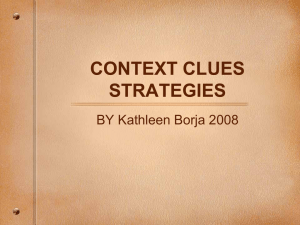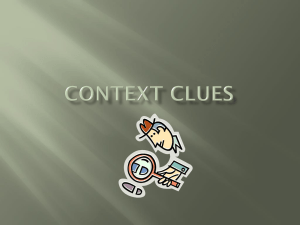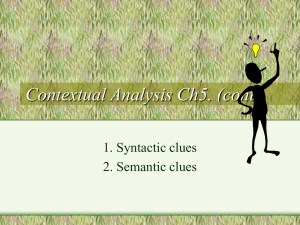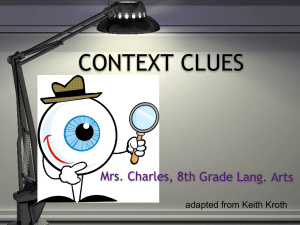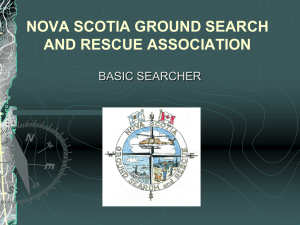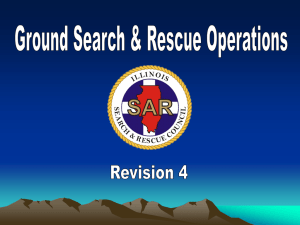Search & Rescue Techniques: Clue Awareness & Tracking
advertisement
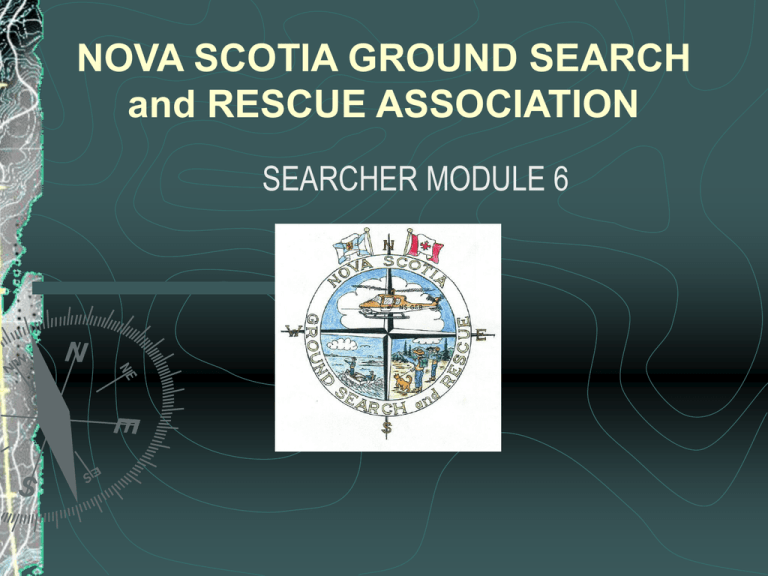
NOVA SCOTIA GROUND SEARCH and RESCUE ASSOCIATION SEARCHER MODULE 6 SEARCHER MODULE 6 SEARCH TECHNIQUES CLUE AWARENESS Observation and seeking clues is the major job of the field searcher and is critical to search success. A single competent clue-finder is worth more than hundreds of untrained grid searchers. Always search for clues before you search for the subject. A Clue is a fact, an object, information, or some type of evidence that helps solve a mystery or problem. The purpose of seeking clues is to assist in the reasoning of a problem and its ultimate solution. CLUE AWARENESS The finding of clues that can be linked to the missing person may provide the basis for search tactics and actions in the field and may eventually lead to the subject’s location. It is virtually impossible to pass through the environment without leaving some trace or evidence. Tracks, scent, disturbances, discarded articles, all indicate the presence of a person in an area. These clues can yield a direction of travel, time and positive identification for a subject, and thus reduce the potential search area size. CLUE AWARENESS Important points to remember regarding clues: There are more clues than subjects. The subject is the ultimate clue. The lack of clues may be a clue in itself (ie. searching in the wrong place). Clue seeking is an ongoing process that continues throughout the mission. Clue seeking is a skill. It must be learned and practiced. Avoid forming opinions and then gathering information to support that opinion. Do not form an opinion about the value of a clue. Gather information from everyone. One person cannot gather all the facts. Assemble a complete profile of the subject and the situation and let it offer direction. TYPES OF CLUES Many forms of clues exist. Most people think of clues as being physical items (ie. discarded wrappers, cigarettes, etc.), however, Intangibles are also clues. 1. Intangible Clues Subject’s state of mind. Destination. Health. Equipment and Clothing. Experience. History. TYPES OF CLUES 2. Weather An important clue. Can force a subject to take cover and become less detectable. Can cause a subject to veer away from a head wind. Can force a boater to the leeward shore. 3. People Witnesses that have seen or talked to the subject are obvious clues. People who knew of the intent or destination of the subject. People who have not seen the subject in a suspected location also provide clues. TYPES OF CLUES 4. Recorded Clues Includes items such as sign-out forms, trail registers, summit logs, trip plans, notes left in cabins, notes left on calendars at home, etc. 5. Event Clues Includes events such as a campfire, signal, light, human voice, sound (whistle), PLB, ELT, etc. 6. Physical Clues Includes discarded items such as wrappers, cigarette butts, tissue, etc. candy TYPES OF CLUES 7. Tracks or Sign Most common type of physical clues. Sign refers to any evidence of a person’s passage. Include things such as footprints, scent, flattened earth, freshly broken branches at shoulder height, bent grass, bruised leaves, etc. Some signs can be positively identified as human in origin, however, some could be made by animals. TRACKING AND SIGN CUTTING Tracking is the process of finding a track or line of sign and staying on it, step by step. This is usually performed by skilled searchers called Trackers. TRACKING AND SIGN CUTTING Sign Cutting is the process of looking for sign. Trackers start by doing a perimeter around the PLS to “Cut Sign” where the subject has left the area. Trackers also cut sign by “Cutting Ahead” or jumping ahead of an established track and moving across the projected line of travel to discover if the subject has continued in that direction. Sign cutting is much more difficult than step-by-step tracking and should only be attempted by experienced individuals. Sign cutting and cutting ahead techniques can quickly reduce the effective size of a search area. THE PROCESS OF TRACKING Trackers generally work in teams of three: a point man and two flankers. After receiving a briefing from relatives, witnesses and the overhead team, they commence the search by cutting a perimeter around the PLS until they find the subject’s track. If the subject’s track is not found, they may search “Track Traps” on logical routes away from the PLS. This process may be the single most time-consuming point of the search, especially if earlier searchers, police or bystanders have crossed or even obliterated the sign. cont’d… THE PROCESS OF TRACKING Trackers may have to cut several perimeters before the first positive sign is found. When a “Signature” track is found and established as that of the subject, it is carefully measured and examined. Markers on a “Tracking Stick” are then adjusted to show track size and pace length. The trail is then followed, with the point man concentrating on the track and the flankers watching for sudden turns or incoming trails. cont’d… THE PROCESS OF TRACKING A complete track is rarely seen. When a track is found, the stick is used to give the approximate location of the next, if it is not seen. Step-by-step tracking is a slow process, however, once the general direction is established, the “Cutting Ahead” stage will commence. In the cutting ahead stage, a second tracking team moves around the first and cuts across the estimated line of travel at right angles – if possible on a feature such as a logging road, stream bed, cut-bank or other area that would readily take an impression. cont’d… THE PROCESS OF TRACKING They must determine if the subject continued in the original direction. They cut for sign and if they find another signature track, they will then radio back to the first team to let them know that they can “cut ahead” in their turn. If there are several teams, the others may be cutting along the outermost potential boundaries or on other track traps or possible travel routes to limit the area to be searched. This leap-frog process will continue until the subject is found or other search tactics are commenced. CLUE PRESERVATION It is very important that clues be preserved, especially those that are easily destroyed. Skilled trackers and hasty teams should be bought in before other search resources. Vehicle tires and searchers tracks can easily erase a lost subject’s tracks, and searchers and bystanders can easily create false clues by crashing through the woods on their own. As a result, searchers must be very conscious of what they may be doing to clues and must be constantly searching for them. cont’d… CLUE PRESERVATION Searchers with limited training should stay out of areas with a high potential for yielding clues until it has been searched thoroughly by trackers or a skilled hasty team. Scent is also a very important clue. There are three types of search dogs; tracking, trailing and air scenting. Most police forces used dogs that are trained to be alert to any recent human scent rather than a specific one. The scent of searchers can easily be a distraction to police dogs. cont’d… CLUE PRESERVATION For police dogs to be effective, they must search an area that has not been contaminated by the scent of searchers. When the early use of police dogs is anticipated, some high probability areas should be kept free of searchers until the dog has finished. The decisions on areas of high probability, timing and on the use of police dogs and search teams are the responsibility of the incident commander and the search management team. Search dogs are most effective in humid conditions and light winds, and can function effectively either day or night. INTERVIEWING WITNESSES IN THE FIELD Occasionally, a searcher may encounter a person in the wilderness other than the subject, and will find it necessary to interview this individual. All responses must be written down and relayed to the search manager. Once contact has been made, searchers should identify themselves and state in general terms only the purpose of the search. The person should be asked to describe where they have been and any people that they have encountered in the area. Ask the person to describe, with as much detail as possible, anyone that they have seen. cont’d… INTERVIEWING WITNESSES IN THE FIELD Avoid putting words in the witness’s mouth and any leading questions. The time and location of any sightings is essential. If possible, have the witness take the searcher to the exact location of the meeting. The direction of travel is vital and the witness should be asked which way the subject was heading. If the witness did not encounter anyone, the possibility of other evidence should be explored. This would include any obvious clues. The precise time and locations of any sighted clues are vital. cont’d… INTERVIEWING WITNESSES IN THE FIELD If the witness is willing to give their name and future whereabouts, record it, but do not press the issue with a reluctant witness. All witnesses should be encouraged to go to the command centre for a further interview with the incident commander or search manager. All witness should be thanked for their assistance. Report all information received from a witness to the command centre. GENERAL SEARCH TECHNIQUES Become clue aware, do not just walk through an area but be constantly on the lookout for clues. Move through a search area slowly, not more than half of your normal walking speed. It is hard to find clues while rushing through the woods. Keep your mind focused on the search at hand rather than whether it is cold, hot, wet or if the terrain is too rough. Dress appropriately so that these factors will not be a hindrance. Do not take so much stuff that its weight and size will cause discomfort and will interfere with your ability to search. cont’d… GENERAL SEARCH TECHNIQUES Use all of your senses while searching. If you do not use all of your senses you will likely miss something. Consciously look up, down and all around while searching. Try to imagine what the subject would do in this situation and environment. Observe to the rear. Look behind often. Looking behind provides a different view of the search area. Wander purposely and never assume anything. Check the obvious and behind or around anything you cannot see around or through. cont’d… GENERAL SEARCH TECHNIQUES Be alert for objects or locations that might attract the missing subject (ie. caves, buildings, lights, natural shelters, etc.) Maintain a positive mental attitude. Maintain mental alertness. Know your limitations and inform the overhead team when you feel that you are no longer being effective due to fatigue or other factors. cont’d… GENERAL SEARCH TECHNIQUES Use sound (ie. whistles) to obtain a response from the missing subject. Talk to any non-searchers that you come across. They may have valuable information that may assist in the search. Be able to briefly but accurately describe the subject to a non-searcher. Do not talk unnecessarily with other searchers in your team. It will distract you from searching and you may not, for instance, hear a call for help. INITIAL RESPONSE SEARCH METHODS As a search begins, the potential search area is usually quite large and the number of SAR personnel is usually quite small. Establishing the initial search area is the most critical step in preparing a search plan. There are two types of Initial Response Search Methods: 1. 2. Passive Methods Active Methods INITIAL RESPONSE SEARCH METHODS Passive Initial Response Methods include: 1. Confinement Confinement techniques attempt to keep the subject within the initial search area. Used as soon as possible in most searches to minimize search area size. Decreases the chances of a massive search. Vital in searches involving walking subjects but becomes impractical in snowmobile/ATV searches due to the vast possible search area. INITIAL RESPONSE SEARCH METHODS Confinement techniques include: Road Blocks – used to intercept the subject if they find a road and either walks along it or finds a ride. They are also used to determine if passers-by have seen the subject and to alert them to keep an eye out for the subject. Trail Blocks – used to prevent lost subjects from travelling deeper into the wilderness along cut trails, old wood roads, power lines, seismic lines, drainages, beaches, shorelines, etc. A trail block should consist of 2-3 members located in a position where a person can be seen approaching for some distance. Look-Outs – used in open areas, where searchers equipped with binoculars may be stationed in areas of high visibility. Look-out teams usually consist of 2 members which operate day and night. cont’d… INITIAL RESPONSE SEARCH METHODS Confinement techniques include: Camp-In – refers to any of the confinement techniques where searchers are stationed on a full-time basis. Generally located on the periphery of the search area. String Lines – used to create an artificial search boundary. Paper tags stuck to the string at intervals tell the lost person which way to proceed. Track Traps – refers to areas where evidence of the subjects passage can been seen. They can be natural or man-made and may consist of soft stream or lake shores, snowbanks, dusty or muddy sections of a trail, road shoulders, boggy areas etc. Combinations – to achieve maximum efficiency and success, many of the confinement techniques may be used in combination with one another. INITIAL RESPONSE SEARCH METHODS Passive Initial Response Methods include: 2. Attraction Searchers produce some form of signal which attracts the lost subject to either respond or walk out on their own. Attraction techniques assume that the subject is Responsive. Attraction techniques include the use of: Sounds – whistles, horns, sirens, gunshots, calls, etc. Visual Beacons in Daylight – smoke, signal panels, weather balloons, reflections, etc. Visual Beacons at Night – lights, fire, flares, etc. Attraction must be used with discretion and plenty of time should be allowed between signals to listen for a response from the subject. INITIAL RESPONSE SEARCH METHODS Attraction techniques include: Calling – most common type of attraction and is generally used in conjunction with confinement techniques when the subject is believed to be responsive. Silence must be kept for 10-30 seconds between calls in order to listen for a response. Assume responsiveness for the first 72 hours of a search. Sound Transmitters – loud sounds such as whistles, sirens, horns or gunshots may be heard over a considerable distance. Lost subjects may proceed to the sound if it is repeated or may simply respond. Stationary sound attraction should be used in conjunction with a visual homing signal (ie. flare) to give the lost subject a better sense of direction. cont’d… INITIAL RESPONSE SEARCH METHODS Attraction techniques include: Loud Sound Attraction and Response (LSAR) – the use of guns or “bear bangers” is an excellent initial response attraction technique. In Newfoundland and Labrador, many individuals who become lost in the wilderness carry firearms. Under good conditions, signal shots from lost subjects can be heard for several kilometres. Police searchers will often carry out LSAR searches using firearms due to their training and legal background. cont’d… INITIAL RESPONSE SEARCH METHODS Attraction techniques include: Airborne LSAR – makes use of a helicopter to transport the “attractor” to systematically arranged attraction points throughout the search area. The helicopter must be shut down at each attraction point. The procedure is outlined as follows: Alert all rescuers by radio of impending signals. Fire two shots, at least 10 sec apart. Listen for several minutes before proceeding to the next attraction point. Scan the search area with binoculars for a visible signal response. If a response is heard, it may be in the form of three shots or three of anything (ie. whistle blasts). Try to get an approximate bearing to the subject and then move to another point and try to get a bearing again. These bearing can be plotted on a map, and by using triangulation, can indicate the subject’s approximate location. Wind plays a major factor. Airborne LSAR should begin upwind of the search area and then progress to downwind attraction points. Signals from a lost subject will be picked up by searchers more clearly downwind. cont’d… INITIAL RESPONSE SEARCH METHODS Attraction techniques include: LSA from Vehicles – makes use of trucks, cars, snowmobiles, ATVs, etc. Two main approaches: Route or Corridor Search – the search vehicle travels along a given route, pausing at specific intervals to stop, signal and listen. Shutting down the engine at each point is critical. Area Search - the search vehicle travels along a predetermined grid pattern, pausing at specific intervals to stop, signal and listen. Shutting down the engine at each point is critical. Visual Beacons – especially useful at night when any light source can attract a subject. Any light source on an elevation is highly visible. Smoke, reflections, signal panels, fire, flares, even a helicopter rising from a landing area, are all useful visual beacons. INITIAL RESPONSE SEARCH METHODS Active Initial Response Methods include: 1. Perimeter Sign Cuts Sign cutter are sent in at the beginning of a search to examine features around the PLS for any signs which may indicate the direction in which the subject traveled. Road shoulders, stream beds, lake shores, trails, wood roads, snow banks, etc., often form boundaries and preserve tracks well. cont’d… INITIAL RESPONSE SEARCH METHODS Active Initial Response Methods include: 2. Quick Reconnaissance Most successful technique for locating lost subjects. Since greater than 50% of missing persons are found on travel aids, initial response tactics should include an active search of roads, trails, ridges and drainages. This is often accomplished with the use of ATVs, 4WDs, snowmobiles, boats, dirt bikes, etc. Be aware that ATVs and snowmobiles are the greatest destroyers of sign. Whenever searchers use motorized equipment, they should understand that Observation is the primary concern and not speed. Searchers should also shut the engine down frequently, use some form of attraction and carefully listen for a response. Ground recon team should consist of three members, with skills in navigation, radio communications and sign-cutting. cont’d… INITIAL RESPONSE SEARCH METHODS Active Initial Response Methods include: 3. Police/SAR Dog Teams 4. If a dog can be brought to the PLS early in the search, before the area has become contaminated by other searchers, the chances of success will be fairly high. The effectiveness of search dogs decreases as a search becomes prolonged over several days especially during hot, dry weather. Aerial Reconnaissance Very effective in open areas and on linear features such as streams, roads, trails and shorelines. Extremely ineffective in forested areas. Helicopters are more effective for searching than fixed-wing aircraft but have extremely high associated costs. Areas searched by aircraft should not be considered well searched. cont’d… INITIAL RESPONSE SEARCH METHODS Active Initial Response Methods include: 5. Forward Looking Infrared (FLIR) This is becoming increasingly popular among policing agencies and search managers as an initial response tool. This helicopter mounted, temperature sensitive unit can scan a swath area of 100-150m wide, and is capable of displaying an on-screen picture with temperature differences of as little as 0.2oC. Human bodies are easily identified if they are not blocked by an obstruction. FLIR is most effective in a cool or cold environment with little forest cover. FLIR is ineffective in dense foliage and has reduced capabilities in hot weather when many objects in the environment will be as warm as the lost subject. It is also difficult to determine if an area has been adequately searched using this technology. Currently, the success rate of FLIR in SAR operations is estimated to be only 5%. In order to avoid confusion, ground searchers and FLIR operators must use mutually agreed upon arm signals. Arms straight out from the body and not over the head are a common signal indicating that the signaller is a searcher and not the lost subject. cont’d… INITIAL RESPONSE SEARCH METHODS Active Initial Response Methods include: 6. Tracking and Sign Cutting As previously discussed, tracking and sign cutting is the single most effective search technique. Step by step tracking can be extremely slow, unless at least two teams are available so that “cutting ahead” can be utilized. Sign cutters should always flag their routes so that their sign is not later mistaken for that of the subject. Sign cutting around a search perimeter and covering all travel routes and natural track traps within it, will often bring the search to a quick conclusion. NIGHT SEARCHING To be an effective searcher, volunteers must know how to search at night. For night searches, it is the duty of the search manager to assess the urgency as well as the probability of success against the risk to searchers. Night searching requires experienced and trained searchers. NIGHT SEARCHING Advantages of Night Searching include: Tracks and sign show up much better at night when illuminated by flashlight. Footprints and tracks are better preserved at night because they do not dry out as quickly thus maintaining their shape and identity. In hot weather, night travel is less strenuous than day travel. Human voices and sounds carry further at night, thus increasing the effectiveness of sound sweeps. Radio transmissions are often better at night. Sounds, smells and light signals are more easily detected by searchers. The subject is usually not mobile at night and is more alert to searcher sounds. NIGHT SEARCHING Disadvantages of Night Searching include: Night searches require a longer search time, which can have a negative impact on victim survival. Possible risk to searchers (ie. hazards). Missing person could be injured attempting to move to or away from searchers. Accidental destruction of clues. Missing vital clues. Use of light hampers searcher’s night vision. Natural fear of dark may cause searcher anxiety. SWEEP SEARCHES Also known as grid searches and requires that search teams “grid” an area following approximately parallel lines. Two common types of sweep searches: Sound Sweeps 2. Visual Sweeps 1. Open Grid (searcher spacing > 10m) Closed Grid (searcher spacing < 10m) Sweep searches are not as simple as they appear and require practice. SWEEP SEARCHES Communications are critical during sweep searches. At a wide spacing, a single whistle blast means STOP. All searchers must then stop until the leader determines the reason for the stoppage. Two whistle blasts means the sweep should resume. Sweep boundaries should be flagged so that two flags of a line are visible at all times. To achieve assigned PODs, teamwork is vital in order to maintain the pattern of the sweep. Do not rush a sweep search; the primary objective is to search the area well. SWEEP SEARCHES SOUND SWEEPS Sound has been found to be many times more effective than sight in finding lost subjects provided: The subject is able and willing to respond The conditions for sound transmission and reception are reasonable. Martin Colwell (1992) developed a sound sweep technique that proves to be quite effective for locating responsive subjects. The sound sweep is a very wide-spaced (210m) open grid search during which searchers blow whistles at specific intervals. This technique completely covers the search area with sound signals and listening for a response at each interval. SWEEP SEARCHES SOUND SWEEPS Teams are generally comprised of three searchers equipped with radios, compasses and loud whistles, plus a team leader. In order to accurately cover the search area, all searchers start from assigned points along a baseline and follow parallel compass courses. Searchers do not need to start simultaneously. The team leader does not follow any of the assigned grid lines, and gives radio commands to stop, blow the whistle and listen (~15 sec) at specific intervals. If no response is heard, the searchers continue with the sweep. Depending on the terrain, the intervals are usually 1 – 2 minutes. SWEEP SEARCHES VISUAL SWEEPS Visual sweeps are used: When the subject cannot or will not respond. When the search area is small enough to search within the estimated survival time. When enough trained searchers are available. Searchers are spaced close enough so that they can see each other most of the time. Visual searchers should also make use of sound and listen at frequent intervals. There is always a chance of even the faintest response. SWEEP SEARCHES VISUAL SWEEPS 1. Open Grid Sweeps An open grid search uses a spacing of greater than 10m and is most effective when: • It is used to search a high probability area. • The subject is believed to be easily visible. An open grid sweep is a compromise between thoroughness and time, however, the POD will increase dramatically with several sweeps. The most effective teams are comprised of three members, with one of the members being the team leader. cont’d… SWEEP SEARCHES VISUAL SWEEPS 1. Open Grid Sweeps If several teams are being used, their starts should be staggered to reduce the possibility of confusion of signals between teams. The outer members of the team flag their route so that the team searching the adjacent swath may guide on the flags. The centre searcher performs the compass work and will be less effective than the flankers as some attention must be devoted to maintaining a bearing. The flankers will carry out “Purposeful Wandering”, which involves maintaining an approximate spacing but wandering slightly from side to side to see better and to check out routes of least resistance. SWEEP SEARCHES VISUAL SWEEPS 2. Closed Grid Sweeps A closed grid search uses a spacing of less than 10m and is useful when: • • • • • The search area is very small (< 1km2). There is a high probability that the subject is in the area. The subject is unresponsive, hiding or dead. Conditions prevent hearing the subject’s response. There is an excess of many trained searchers available. Closed grid searches are a last resort and should only be used when initial response and open-grid sweep searches prove unsuccessful. Closed grid searches are often unsuccessful due to the large amount of time required to locate a subject. SWEEP SEARCHES VISUAL SWEEPS Closed Grid Search Procedures Teams should be comprised of 6 – 10 members. The search area must be flagged in advance. This includes: • The baseline, from which the search starts. • The datum lines, which confine the sides of the search area at 90o to the baseline. • The sweep boundary, where the sweep ends. • The boundaries for each search team swath. cont’d… SWEEP SEARCHES VISUAL SWEEPS Closed Grid Search Procedures Team sweep width is determined using the following formula: • Searcher spacing X number of searchers Thus, 8 searchers with 5m spacing would result in a sweep width of 40m. End searchers of each sweep team work one half of the spacing from the sweep boundary, thus maintaining a 5m spacing from the end searcher in the adjoining swath. To maintain the line, the end searchers will guide on the flagged boundaries, while the searchers to the left of centre use the searcher to their left as a guide and those to the right of centre use the searcher to their right as a guide. cont’d… SWEEP SEARCHES VISUAL SWEEPS Closed Grid Search Procedures To maintain spacing, no searcher should get too far ahead or fall too far behind. Rather than trying to maintain a straight line, search teams should use a sagging line. The sagging line allows searchers to keep track of their position using their peripheral vision rather than having to look fully to the left or the right and thus possibly reducing their fine detail search ability. cont’d… SWEEP SEARCHES VISUAL SWEEPS Closed Grid Search Procedures To begin the closed grid search: • The searchers line up on the baseline at a predetermined spacing. • The end searchers should be one-half the spacing distance from the side boundaries. • The leader must ensure that all searchers are familiar with the signals; a single whistle blast for “stop” and two blasts for “go”. • When the first “go” signal is given, the end searchers move out first and then each successive searcher begins to move when their guide is within their peripheral vision. • The leader will then “float” behind the team, giving commands and ensuring that all members maintain their spacing. • To avoid confusion, multiple teams searching adjoining swaths should stagger their start times. cont’d… SWEEP SEARCHES VISUAL SWEEPS Closed Grid Search Procedures Closed grid searchers should remember the following: • They are expected to find all clues and check every hiding place for the subject. • Look for anything that does not appear natural. • Look forward, to the sides, backward, and even up trees. • Maintain spacing with great accuracy. • Maintain the search line while moving. CRITICAL SEPERATION A technique used to determine the spacing for open grid searches in terrain where the POD is unknown or when POD tables are unavailable. The following outlines the procedure for determining the critical separation for any given set of terrain conditions: Place an object on the ground that bears some relation (size, shape, colour, etc.) to that which is being sought. Two searchers then walk away from the object in opposite directions until it is out of sight, and then move back toward it until they reach a point where it just becomes visible. The distance between the two searchers should be noted. The searchers then turn 90o to the object and repeat the process, again making note of the distance. The average of the two results will yield the critical separation. cont’d… CRITICAL SEPERATION By using the critical separation, each searcher should theoretically be able to see something halfway between them. Through experiment it has been determined that a search at one critical separation produced a POD of ~50%, that half a critical separation produced a POD of ~75%, and that two critical separations produced a POD of ~25%. With critical separation, approximate POD’s can be determined for any type of cover, day or night, clear or low visibility. INLAND WATER AND SHORELINE SEARCHES Drowning is one of the greatest hazards in wilderness travel. A Red Cross study shows that the Atlantic Provinces have almost twice the national rate of drowning in which; 83% of victims are male, the majority are a result of boating accidents and alcohol plays a major role. Searcher safety is a major concern in water searches. Water rescue must only be attempted by trained specialists. Shoreline searchers can recover subjects using pike poles or grapples but should never enter the water. INLAND WATER AND SHORELINE SEARCHES River Searches With the continuing increase in recreational boating and kayaking, river accidents are becoming more and more common. While most rivers are fairly linear and easy to search, subjects may drag themselves out of the river and into the bush, thus resulting in a further area search. River searches are usually a high urgency since in many cases, the subjects will be suffering from some degree of hypothermia. Search managers must also take into account the “survival zone”, which is the downstream distance within which a person floating at maximum current velocity can reasonably be expected to have survived. cont’d… INLAND WATER AND SHORELINE SEARCHES River Searches The survival zone varies depending on: Water temperature. Subjects clothing, condition and experience. The roughness of the water. A person is generally unable to continue swimming for more than 10-15 minutes in water colder than 10oC. Most people are unable to hold their breath for more than 15 – 25 seconds in water colder than 15oC. River searchers should always carry First-Aid equipment and a means for preserving body heat (ie. hypo bag, sleeping bag, fire-making materials, shelter, high-energy foods, etc.) INLAND WATER AND SHORELINE SEARCHES River Searches Small River Searches A small river contains few islands or multiple channels that require separate investigation and both banks can be searched simultaneously from an aircraft. Initial river searches should be carried out by aircraft or boat. Aircraft searches are preferred however, if boat searches are used, the initial response should involve a fast boat to carry out a quick search, followed with slower boats performing more detailed searching. cont’d… INLAND WATER AND SHORELINE SEARCHES River Searches Small River Searches Foot searches of river banks are extremely slow but should be performed as follows: • • • • • • • • Numerous small teams search separate segments of the river bank. Teams should consist of 2-3 members. Teams work down the river from the PLS on opposite banks. A confinement team should be placed at the theoretical maximum downstream distance as lookouts. Teams on opposite riverbanks should coordinate by radio as sometimes the team on the far side will be able to see into areas invisible to those on the near side. Due to urgency, many teams as possible should be searching the river simultaneously from various access points. Searchers must be aware of riverbank sign, in the event that that subject escaped from the river and moved into the bush seeking shelter. If there is evidence that the subject left the water and entered the bush, an open bush search should be initiated. cont’d… INLAND WATER AND SHORELINE SEARCHES River Searches Small River Searches With all water-related incidents, there is always the possibility that the subject may have drowned. Certain features tend to trap bodies and should be carefully investigated. These include: • • • • • Logs jams and sweepers. Bottoms of pools. Sandbars. “Holes” where water over an obstacle recirculates vertically. Eddies. INLAND WATER AND SHORELINE SEARCHES River Searches Big River Searches Big rivers are very wide, with numerous islands, sandbars and multiple channels. Big rivers are often turbid making it difficult to spot submerged objects. Islands and banks must be searched carefully in the event that the subject may have come ashore and entered the bush for shelter. Searchers must be constantly on the lookout for tracks where a subject has come ashore, discarded items (ie. lifejacket) and for signals (ie. smoke) in the bush. cont’d… INLAND WATER AND SHORELINE SEARCHES River Searches Big River Searches Any debris from the incident found above the water line is a clue to a survivor in the area. All searchers should record and flag their routes so that later searchers are not misled by their sign. Searchers must report and plot all debris which appears to have come from the incident. The location of a swamped boat is a critical clue as it will help identify current patterns and suggest a subject’s drift path. INLAND WATER AND SHORELINE SEARCHES Shoreline Searches Shoreline searches are usually a high urgency due to the risks of drowning and hypothermia. Subjects are generally found downwind of the incident. Searches generally start on a downwind shore near the location of flotsam or wreckage. Searchers must be constantly on the lookout for sign that would indicate that the subject has left the area. cont’d… INLAND WATER AND SHORELINE SEARCHES Shoreline Searches Sandy shorelines are excellent track traps. Sign cutting teams should pay particular attention to obvious travel routes away from the wreckage. If track traps are good and there is no sign, it is an indication that the subjects have not survived or may have come ashore elsewhere. Particular attention must be paid to areas of driftwood and debris accumulation. These areas should be carefully checked for clues or bodies. REFERENCES Merry, Wayne, 1999, Basic Ground Search and Rescue in Canada: A Home Study Guide, Context North. Smith, Richard; LaValla, Richard; Hood, Rick, Lawson, Norm and Kerr, Guy, 2003, Field Operating Guide to Search and Rescue (FOG SAR) - SAR Skills Handbook, ERI Canada, Alberta, Canada. Newfoundland and Labrador Search and Rescue Association, 2002, Provincial Training Standards Manual. Colwell, Martin, SAR Technology Inc., 2004, Search Manager 3.0 Incident Command Software.
